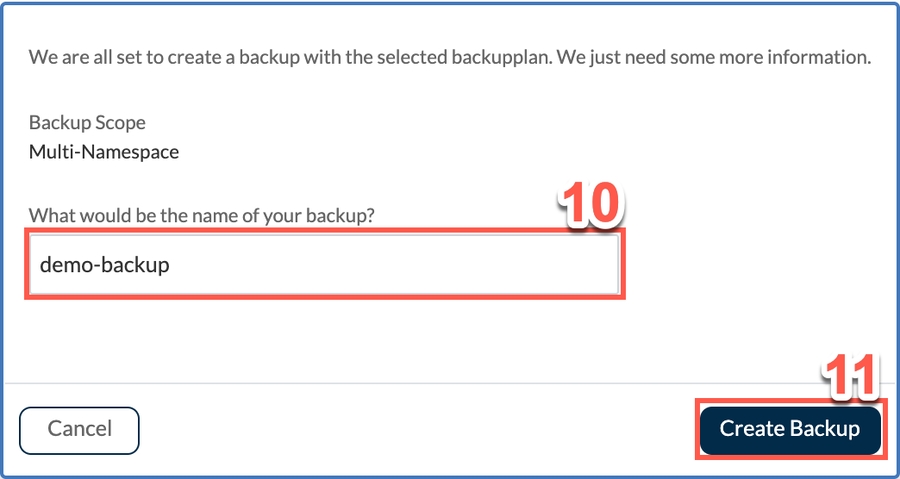Namespaces - Bulk Actions
This page lists various bulk actions that may be executed by a user for multiple namespaces.
Last updated
Was this helpful?
This page lists various bulk actions that may be executed by a user for multiple namespaces.
Last updated
Was this helpful?
From the Backup & Recovery's Namespace page, identify the listed namespaces for which you wish to perform an action.
Select some by clicking the corresponding selector checkboxes in the first column. Use the table header row checkbox to select/deselect all listed namespaces.
This shows the selected and number of Namespaces. Alternatively, click Unselect all to cancel your selections.
Click the Create Backup button in the top-right corner of the main UI window to start the backup process. Alternatively, click Create Snapshot to initiate the snapshot process.
From the CREATE NEW BACKUP (CREATE NEW SNAPSHOT for Snapshot) wizard displayed, check if any existing backup plans are available, either under Last Successful Backup or under Based on Application properties. If you see an existing backup plan that suits, skip to step 7.
If no existing plan is suitable or not available, select Create New and follow the instructions in .
Select either an existing backup plan identified in Step 5, or a new backup plan created in Step 6.
If you just created one, it may take some time before it becomes active and is able to be selected. You can expand any listed backup plan to see more details about its configuration.
Select Next.
In the window displayed, type a meaningful name for your new backup (name for Snapshot if creating Snapshot).
Then click Create Backup (click Create Snapshot if creating the snapshot).
Once the backup (Snapshot) is complete, the STATUS LOG window displays, detailing the status of the backup (Snapshot) and if there were any errors.
From the Backup & Recovery's Namespace page:
This shows the selected namespaces to Restore
On click on Create Restore, It initiates a restore based on last successful Backup or Snapshot.
If last successful is Backup, Restore will be initiate for that Backup.
If last successful is Snapshot, Restore will be initiate for that Snapshot.
On click on Restore Create Namespace Restore model get open and for furthere Refer Restoring Backups & Snapshots
From the Backup & Recovery's Namespace page, identify the listed namespaces for which you wish to perform an action.
Alternatively, click Unselect all to cancel your selections.
Click the Bulk Actions button on the top right of the main UI window.
From the menu displayed, select View Backup & Restore summary, which displays the Monitoring window.
From the Monitoring window, optionally you may view the information provided in the BACKUP SUMMARY panel.
From the Monitoring window, optionally you may view the information provided in the RESTORE SUMMARY panel.
From the Monitoring window, optionally you may view the information provided in the SNAPSHOT SUMMARY panel.
In the Monitoring window, all Restore Points are listed in the table.
a
This table lists the latest Available Backups and Snapshots of selected Namespace and the other columns provides data about those Backup and Snapshots.
b
Click on any Backup or Snapshots expand icon in the table for more details, such as: - Restore - View Restores - Status Logs - View Metadata - Delete - View YAML
c
This shows the first namespace and the number of other namespaces selected, or from which the backups and snapshots were created.
From the Backup & Recovery's Namespace page, identify the listed namespaces for which you wish to perform an action.
Alternatively, click Unselect all to cancel your selections.
Click the Bulk Actions button on the top right of the main UI window.
a
This is the number of namespaces selected.
b
These numbers show how many namespaces are protected and how many are unprotected.
c
This lists each namespace and shows if it is protected or unprotected.
d
On click on this user redirects to GVK visibility page for that particular Namespace.
i
Shows the selected namespace name.
j
Shows the available GVK resources from the Namespace.
k
On click on this user redirects to see the available resources of selected Group.
m
Shows the selected namespace name.
n
Shows the name of selected GVK from step 5.
o
On click on this user see the YAML files of the resources.
From the Backup & Recovery's Namespace page, identify the listed namespaces for which you wish to perform an action.
Alternatively, click Unselect all to cancel your selections.
Click the Bulk Actions button on the top right of the main UI window.
a
The total space consumed by all selected targets for both all and object store targets..
b
This table lists shows the targets selected of selected Namespace with following columns - Status - Target Name - Type - Space Available - Vendor - Space Consumed
c
On click on setting icon user can manage the columns visibility in listing.
Identify the listed namespace for which you wish to perform an action.
From the menu displayed, select Create Restore. This is enable only when the last successful Backup or Snapshot is available. If any of the Namespace is not protected or no Backup/ Snapshot is visible, then that button is disable and respective message is visible on hover that button like below.
Select some by clicking the corresponding selector checkboxes in the first column. Use the table header row checkbox to select/deselect all listed namespaces.
Select some by clicking the corresponding selector checkboxes in the first column. Use the table header row checkbox to select/deselect all listed namespaces.
From the menu displayed, select View Namespace details, which displays the following window**.**
From the above "d" option user redirects to GVK visibility
From the above "k" option user redirects to GVK resources visibility
Select some by clicking the corresponding selector checkboxes in the first column. Use the table header row checkbox to select/deselect all listed namespaces.
From the menu displayed, select View Target summary.
















